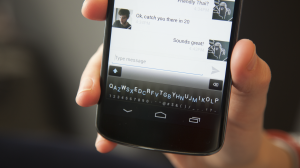Minuum to end battle between mobile screen space and virtual keyboards
Start-up launches Indiegogo campaign to change future of mobile typing

TORONTO, March 18, 2013 — Whirlscape Inc., a Canadian tech start-up, has developed Minuum, “the little keyboard for big fingers.”
Updated: The company has now cleared its $60,000 stretch goal to build a wearable development kit. Read the Mobile Syrup follow-up story.
Minuum’s crowdfunding campaign was covered by the Financial Post, CBC News, CTV News, the Toronto Star and Metro Morning (radio interview). They also did a second spot on CTV News‘s Tech Tuesday report and were featured on Global TV’s The Morning Show.
The story was also picked up by Fast Company, Mashable, CNET, TechCrunch, TechCrunch Japan, TechVibes, Huffington Post, Toronto Standard, BlogTO and Mobile Syrup.
Minuum is a tiny, one-dimensional keyboard that frees up mobile screen space while allowing fast, accurate typing. Its specialized, patent-protected auto-correction algorithm corrects highly imprecise typing.
This algorithm, based on the touchscreen and wearable device research of company founders, Will Walmsley (researcher) and Khai Truong (associate professor) at the University of Toronto, configures the difference between what you type and what you mean, in real time, getting it right even if you miss every single letter.

